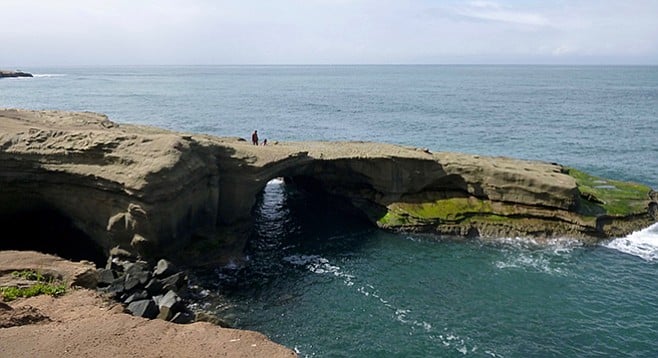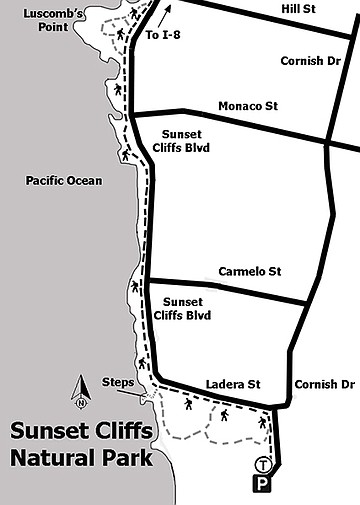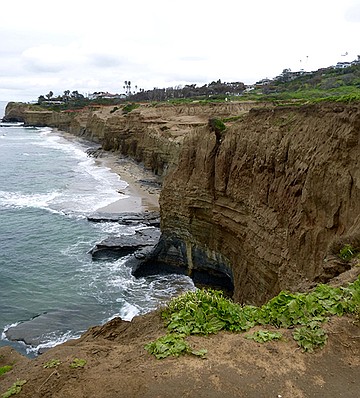 Facebook
Facebook
 X
X
 Instagram
Instagram
 TikTok
TikTok
 Youtube
Youtube

Sunset Cliffs Natural Park, a 68-acre City of San Diego regional park, offers spectacular sunset viewing, as implied by the name, however beauty can be found at any time of day. The park is most commonly enjoyed as a 1.5-mile walk along sheer cliff faces along Sunset Cliffs Boulevard from its intersection with Adair Street in the north to Ladera Street in the south. This portion of the 18-acre Linear Section of the park is complemented by a hillside component which encompasses land at the south end of the park. Parking in the lot just off Ladera Street gives easy access to both sections of the park, and is often more plentiful than parking along Sunset Cliffs Boulevard. If parking in the lot, begin the trail on the north end of the parking lot, which immediately descends with a few stairs. Follow the trail along a 1.5 mile stretch of Sunset Cliffs Boulevard before turning back to return to your car.

Dramatic ocean views and impressive cliffs overlooking pocket beaches are the hallmark of this park. The sandstone cliffs erode naturally with wave action, though this process is dramatically hastened by urban runoff. A walk along the Linear Section of the park shows many examples of human-caused erosion. In some areas, one must venture onto sections of the main road, however, these sections are separated from traffic by small barriers. If you visit the park between December and March, head down to one of the benches near the intersection of Hill Street to look for migrating gray whales in the distance. This is also a great spot to watch sea birds such as pelicans, western gulls, and cormorants glide above the ocean’s surface. The stairs at the corner of Ladera Street and Sunset Cliffs Boulevard offer a breathtaking journey down the cliffs to the north end of Garbage Beach which can be explored at low tide.

As you observe the vegetation throughout the park, many of the plants you will encounter are invasive species. These plants evolved in other geographic areas and were brought to California. They often spread rapidly and make habitat unsuitable for animals that once called the area home. While they add color to the landscape, their sinister effects on the area’s ecology should not be overlooked. Crystalline iceplant (Mesembryanthemum crystallinum) with succulent leaves, Prickly-Russian thistle (Salsola tragus) which resembles a very spiky tumbleweed, Bermuda Buttercup (Oxalis pes-caprae) with bright yellow flowers and heart-shaped leaves, the wide-leaved Cheeseweed (Malva parviora), and Garland Daisy (Glebionis coronaria) with lacey leaves and cheery flowers are abundant. In contrast to these invasive species, California encelia or sunflower (Encelia californica) is a native shrub that blooms abundantly in the spring months and adds a welcome sunflower-yellow flower to the cliffs. Heading south from the parking lot, you will notice a revegetated area that is filled with native species including juvenile Torrey pine (Pinus torreyana).
Distance from downtown San Diego: approximately 9 miles. Allow 20 minutes driving time (Point Loma). From I-5 N take I-8 W until the terminus then turn south (left) onto Sunset Cliffs Boulevard for 3.2 miles. At the end veer to the left onto Ladera Street. Park in the signed parking lot towards the end of Ladera Street. Alternatively, intermittent parking can be found along Sunset Cliffs Blvd past the intersection with Adair Street. Facilities in the Ladera Street parking lot.
Hiking length: 3.0 miles round trip.
Difficulty: Easy. Minimal change in elevation (less than 50 feet). Check tide schedule.


Sunset Cliffs Natural Park, a 68-acre City of San Diego regional park, offers spectacular sunset viewing, as implied by the name, however beauty can be found at any time of day. The park is most commonly enjoyed as a 1.5-mile walk along sheer cliff faces along Sunset Cliffs Boulevard from its intersection with Adair Street in the north to Ladera Street in the south. This portion of the 18-acre Linear Section of the park is complemented by a hillside component which encompasses land at the south end of the park. Parking in the lot just off Ladera Street gives easy access to both sections of the park, and is often more plentiful than parking along Sunset Cliffs Boulevard. If parking in the lot, begin the trail on the north end of the parking lot, which immediately descends with a few stairs. Follow the trail along a 1.5 mile stretch of Sunset Cliffs Boulevard before turning back to return to your car.

Dramatic ocean views and impressive cliffs overlooking pocket beaches are the hallmark of this park. The sandstone cliffs erode naturally with wave action, though this process is dramatically hastened by urban runoff. A walk along the Linear Section of the park shows many examples of human-caused erosion. In some areas, one must venture onto sections of the main road, however, these sections are separated from traffic by small barriers. If you visit the park between December and March, head down to one of the benches near the intersection of Hill Street to look for migrating gray whales in the distance. This is also a great spot to watch sea birds such as pelicans, western gulls, and cormorants glide above the ocean’s surface. The stairs at the corner of Ladera Street and Sunset Cliffs Boulevard offer a breathtaking journey down the cliffs to the north end of Garbage Beach which can be explored at low tide.

As you observe the vegetation throughout the park, many of the plants you will encounter are invasive species. These plants evolved in other geographic areas and were brought to California. They often spread rapidly and make habitat unsuitable for animals that once called the area home. While they add color to the landscape, their sinister effects on the area’s ecology should not be overlooked. Crystalline iceplant (Mesembryanthemum crystallinum) with succulent leaves, Prickly-Russian thistle (Salsola tragus) which resembles a very spiky tumbleweed, Bermuda Buttercup (Oxalis pes-caprae) with bright yellow flowers and heart-shaped leaves, the wide-leaved Cheeseweed (Malva parviora), and Garland Daisy (Glebionis coronaria) with lacey leaves and cheery flowers are abundant. In contrast to these invasive species, California encelia or sunflower (Encelia californica) is a native shrub that blooms abundantly in the spring months and adds a welcome sunflower-yellow flower to the cliffs. Heading south from the parking lot, you will notice a revegetated area that is filled with native species including juvenile Torrey pine (Pinus torreyana).
Distance from downtown San Diego: approximately 9 miles. Allow 20 minutes driving time (Point Loma). From I-5 N take I-8 W until the terminus then turn south (left) onto Sunset Cliffs Boulevard for 3.2 miles. At the end veer to the left onto Ladera Street. Park in the signed parking lot towards the end of Ladera Street. Alternatively, intermittent parking can be found along Sunset Cliffs Blvd past the intersection with Adair Street. Facilities in the Ladera Street parking lot.
Hiking length: 3.0 miles round trip.
Difficulty: Easy. Minimal change in elevation (less than 50 feet). Check tide schedule.
Comments